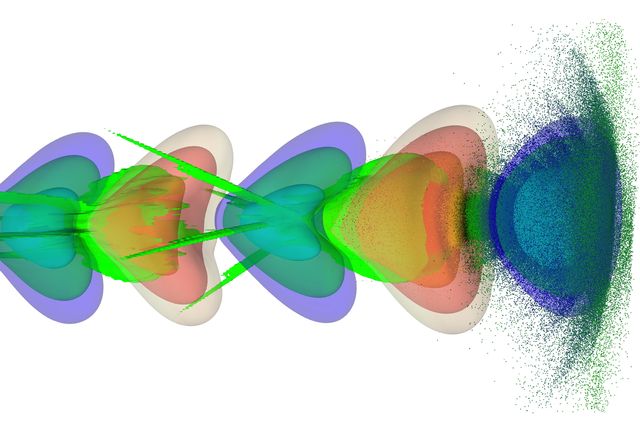Researchers from UCLA and the Department of Energy’s SLAC National Accelerator Laboratory have shown that a promising technique for accelerating electrons on waves of plasma is efficient enough to power a new generation of shorter, more economical accelerators. This could greatly expand their use in areas such as medicine, national security, industry and high-energy physics research.
This achievement is a milestone in demonstrating the practicality of plasma wakefield acceleration, a technique in which electrons gain energy by essentially surfing on a wave of electrons within an ionized gas.
Using SLAC’s Facility for Advanced Accelerator Experimental Tests, a Department of Energy Office of Science User Facility, the researchers boosted bunches of electrons to energies 400 to 500 times higher than they could reach traveling the same distance in a conventional accelerator. Just as important, energy was transferred to the electrons much more efficiently than in previous experiments. This crucial combination of energy and efficiency had never been reached before. The results are described in a paper to be published in the Nov. 6 issue of the journal Nature.
Chandrashekhar Joshi, professor of electrical engineering at the UCLA Henry Samueli School of Engineering and Applied Science, led the team that developed the plasma source used in the experiment. Joshi, the director of the Neptune Facility for Advanced Accelerator Research at UCLA is the UCLA principal investigator for this research and is a long-time collaborator with the SLAC group.
SLAC accelerator physicist Mike Litos is lead author of the paper, Mark Hogan, also an accelerator physicist at SLAC, is a principal investigator on the research. Computer simulations used in the experiments were developed by a group led by Warren Mori, a UCLA professor of physics, astronomy, and electrical engineering.
Plasma wakefields have been of interest to accelerator physicists for 35 years as one of the more promising ways to drive the smaller, cheaper accelerators of the future. The UCLA and SLAC groups have been at the forefront of research on plasma wakefield acceleration for more than a decade. In a 2007 paper, researchers announced they’d accelerated electrons in the tail end of a long electron bunch from 42 billion electron volts to 85 billion electron volts, causing a great deal of excitement in the scientific community. However, fewer than 1 billion of the 18 billion electrons in the pulse actually gained energy and they had a wide spread of energies, making them unsuitable for experiments.
In this experiment, researchers sent pairs of electron bunches containing 5 billion to 6 billion electrons each into a laser-generated column of plasma inside an oven of hot lithium gas. The first bunch in each pair was the drive bunch; it blasted all the free electrons away from the lithium atoms, leaving the positively charged lithium nuclei behind — a configuration known as the “blowout regime.” The blasted electrons then fell back in behind the second bunch of electrons, known as the trailing bunch, forming a “plasma wake” that propelled the trailing bunch to higher energy.
Previous experiments had demonstrated multi-bunch acceleration, but the team at SLAC was the first to reach the high energies of the blowout regime, where maximum energy gains at maximum efficiencies can be found. Of equal importance, the accelerated electrons wound up with a relatively small energy spread.
“It is gratifying to see that the UCLA-SLAC collaboration on plasma wakefield acceleration continues to solve seemingly intractable problems one by one through systematic experimental work,” Joshi said. “It is this kind of transformative research that attracts the best and the brightest students to this field.”
Additional contributors included researchers from SLAC, the University of Oslo in Norway, Tsinghua University in China and Max Planck Institute for Physics in Germany. The research was funded by the Department of Energy Office of Science.
Watch a video of researchers at SLAC explaining how they use plasma wakefields to accelerate bunches of electrons to very high energies over only a short distance.





